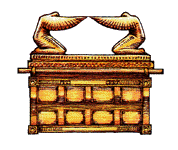Tunnel by the Western Wall
To the north the Western Wall with its enormous blocks of stone is met by the wall of a building made of much smaller blocks of stone and built by the Arab conquerors of the land. Here is a complex of passages, halls and chambers at different levels, the lower ones dating back to Herodian times and before. At the level of the Western Wall plaza these are Jewish places of prayer. To the north of this complex building the Western Wall is inaccessible because the buildings of the Muslim Quarter are packed tight against the Temple Mount.
In the time of Jesus there were four entrances to the Temple Mount along the southern half of the Western Wall, and the remains of each are still discernible. Today they are named after nineteenth-century explorers of the remains of ancient Jerusalem. From south to north they are Robinson's Arch, Barclay's Gate, Wilson's Arch and Warren's Gate. The first two refer to entrances the traces of which can be seen in the exposed southern section of the Western Wall. At the level of the top of Wilson's arch was a bridge across the now filled-in Tyropeon Valley into the Temple Mount. The fourth entrance, Warren's Gate, is not visible from outside, but was discovered originally by the British military engineer Charles Warren when tunnelling below the level of the houses.
As part of the
archaeological investigations of the Old City of Jerusalem
from 1967 onwards, a tunnel has been driven along the
Western Wall northwards from the complex of buildings at Wilson's
Arch, below the level of the present houses. In recent years
this has been opened up to visitors, and in May 1990 we were
conducted as part of a guided party along the length of
this tunnel. At that time only escorted parties were
allowed; now, we understand, it is open to all at set
times.
Shortly after entering the tunnel we paused at an arch. This marks where Warren's Gate entered the Temple Mount, although the present arch is considered to date to the eleventh century A.D. The significance of this entrance to the Temple Mount is that it is located opposite what is generally thought to be the site of the temple itself, with the holy of holies being, of course, the nearest point, since the entrance to the temple was to the east.
After the Bar Kochba revolt of A.D. 132-135, the Jews were no longer permitted in Jerusalem. In essence this remained the case until the Arabs conquered the land in A.D. 638. When the Jews settled in Jerusalem they began to meet for prayer in the vaulted gateway of Warren's Gate, which became the holiest place of Jewry because of its proximity to the site of the temple. Following an earthquake in 1033 they rebuilt it with money raised by a special appeal to Jews in the Dispersion, and it is this structure that now exists there. However, when the Crusaders conquered Jerusalem in 1099 they slaughtered the Jews of the city. After the end of the period of Crusader rule the Mamluks (Mamelukes), a line of Sultans who ruled from Cairo, built over this area, and the Jews, when they returned, had to make do with the area now called the Western Wall, as their holy site.
However, the rediscovered
Warren's Gate, with its vaulted passageway under the
Temple Mount, is sealed by concrete, rendering access
impossible. Why is this? In a book entitled Ready to
Rebuild9 two American authors suggest a
dramatic possibility: that here, in a secret chamber
under the Dome of the Rock, lies the ark of the covenant.
Next section: The Ark Under the Temple Mount

